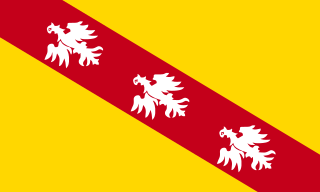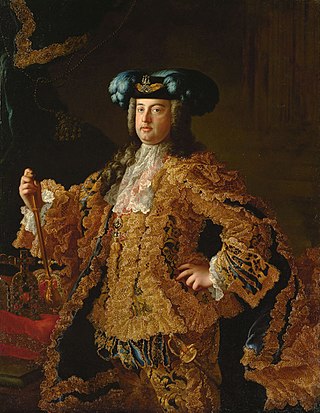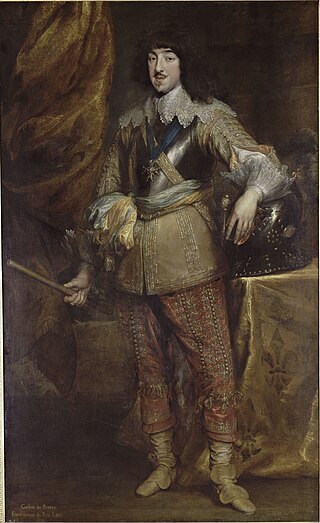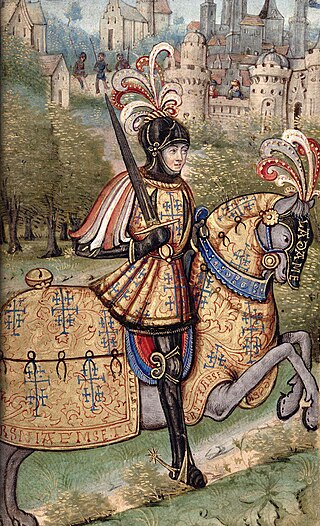| |||||
| Decades: | |||||
|---|---|---|---|---|---|
| See also: | Other events of 1428 History of France • Timeline • Years | ||||
Events from the year 1428 in France
| |||||
| Decades: | |||||
|---|---|---|---|---|---|
| See also: | Other events of 1428 History of France • Timeline • Years | ||||
Events from the year 1428 in France

The Duchy of Lorraine, originally Upper Lorraine, was a duchy now included in the larger present-day region of Lorraine in northeastern France. Its capital was Nancy.

René of Anjou was Duke of Anjou and Count of Provence from 1434 to 1480, who also reigned as King of Naples as René I from 1435 to 1442. Having spent his last years in Aix-en-Provence, he is known in France as the Good King René.

Francis I was Holy Roman Emperor, Archduke of Austria, Duke of Lorraine and Bar, and Grand Duke of Tuscany. He became the ruler of the Holy Roman Empire, Austria, and Tuscany through his marriage to Maria Theresa, daughter of Emperor Charles VI. Francis was the last non-Habsburg monarch of both the Empire and Austria, which were effectively governed by Maria Theresa. The couple were the founders of the Habsburg-Lorraine dynasty, and their marriage produced sixteen children.

Lotharingia was a short-lived medieval successor kingdom of the Carolingian Empire. As a more durable later duchy of the Ottonian Empire, it comprised present-day Lorraine (France), Luxembourg, Saarland (Germany), Netherlands, and the eastern half of Belgium, along with parts of today's North Rhine-Westphalia (Germany), Rhineland-Palatinate (Germany) and Nord (France). It was named after King Lothair II, who received this territory after his father Lothair I's kingdom of Middle Francia was divided among his three sons in 855.

Alsace–Lorraine, now called Alsace–Moselle, is a historical region located in modern day France. It was created in 1871 by the German Empire after it had seized the region from the Second French Empire in the Franco-Prussian War with the Treaty of Frankfurt. Alsace–Lorraine reverted to French ownership in 1918 as part of the Treaty of Versailles and Germany's defeat in World War I.

MonsieurGaston, Duke of Orléans, was the third son of King Henry IV of France and his second wife, Marie de' Medici. As a son of the king, he was born a Fils de France. He later acquired the title Duke of Orléans, by which he was generally known during his adulthood. As the eldest surviving brother of King Louis XIII, he was known at court by the traditional honorific Monsieur.

René II was Count of Vaudémont from 1470, Duke of Lorraine from 1473, and Duke of Bar from 1483 to 1508. He claimed the crown of the Kingdom of Naples and the County of Provence as the Duke of Calabria 1480–1493 and as King of Naples and Jerusalem 1493–1508. He succeeded his uncle John of Vaudémont as Count of Harcourt in 1473, exchanging it for the county of Aumale in 1495. He succeeded as Count of Guise in 1504.

The House of Lorraine originated as a cadet branch of the House of Metz. It inherited the Duchy of Lorraine in 1473 after the death without a male heir of Nicholas I, Duke of Lorraine. By the marriage of Francis of Lorraine to Maria Theresa of Austria in 1736, and with the success in the ensuing War of the Austrian Succession (1740–1748), the House of Lorraine was joined to the House of Habsburg and became known as the House of Habsburg‑Lorraine. Francis, his sons Joseph II and Leopold II, and his grandson Francis II were the last four Holy Roman emperors from 1745 until the dissolution of the empire in 1806. The House of Habsburg-Lorraine inherited the Habsburg Empire, ruling the Austrian Empire and then Austria-Hungary until the dissolution of the monarchy in 1918.

The County of Bar, later Duchy of Bar, was a principality of the Holy Roman Empire encompassing the pays de Barrois and centred on the city of Bar-le-Duc. It was held by the House of Montbéliard from the 11th century. Part of the county, the so-called Barrois mouvant, became a fief of the Kingdom of France in 1301 and was elevated to a duchy in 1354. The Barrois non-mouvant remained a part of the Empire. From 1480, it was united to the imperial Duchy of Lorraine.

Saint-Dié-des-Vosges, commonly referred to as just Saint-Dié, is a commune in the Vosges department, Grand Est, northeastern France.

Lorraine is a cultural and historical region in Northeastern France, now located in the administrative region of Grand Est. Its name stems from the medieval kingdom of Lotharingia, which in turn was named after either Emperor Lothair I or King Lothair II. Lorraine later was ruled as the Duchy of Lorraine before the Kingdom of France annexed it in 1766.

Eleonore Maria Josefa of Austria was Queen of Poland and Grand Duchess of Lithuania by marriage to King Michał Korybut Wiśniowiecki, and subsequently Duchess of Lorraine by her second marriage to Charles V, Duke of Lorraine. She acted as nominal regent of the Duchy of Lorraine during the minority of her son between 1690 and 1697.

Élisabeth Charlotte d'Orléans was a petite-fille de France and duchess of Lorraine and Bar by her marriage to Leopold, Duke of Lorraine and Bar. She was regent of the duchy during the minority (1729–1730) and absence (1730–1737) of her son and suo jure princess of Commercy 1737–1744. Among her children was Francis I, Holy Roman Emperor, the co-founder of theHouse of Habsburg-Lorraine.
Events from the year 1952 in France.

Marguerite of Lorraine, Duchess of Orléans, was the wife of Gaston, younger brother of Louis XIII of France. As Gaston had married her in secret in defiance of the King, Louis had their marriage nullified when it became known. On his deathbed, Louis permitted them to marry. After their remarriage, Marguerite and Gaston had five children. She was the stepmother of La Grande Mademoiselle.

Nicole was reigning Duchess of Lorraine and Bar from 1 August 1624 to 21 November 1625, and duchess consort of Lorraine in 1625–1634. She was born in Nancy, the daughter of Henry II, Duke of Lorraine and Bar, and Margherita Gonzaga.
The Union of Protestant Churches of Alsace and Lorraine was created in 2006 by bringing together the Protestant Church of Augsburg Confession of Alsace and Lorraine (EPCAAL) and the Protestant Reformed Church of Alsace and Lorraine (EPRAL).

Grand Est is an administrative region in Northeastern France. It superseded three former administrative regions, Alsace, Champagne-Ardenne and Lorraine, on 1 January 2016 under the provisional name of Alsace-Champagne-Ardenne-Lorraine, as a result of territorial reform which had been passed by the French Parliament in 2014.
Events from the year 1712 in France
Events from the year 1634 in France.